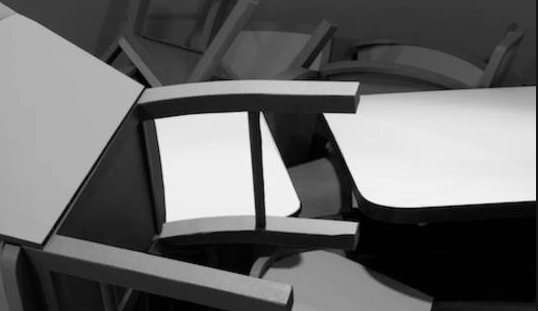Thomas Demand
dal 18/1/2013 al 11/5/2013
Segnalato da
18/1/2013
Thomas Demand
DHC/ART Foundation for Contemporary Art, Montreal
Animations. Emerging as a philosophical commentator on the status of the real, the notion of photography as evidence, and the workings of visual memory, Demand's art has the uncanny effect of summoning something indefinitely remembered, while almost always concealing an intriguing and exhaustively researched back story.

curated by John Zeppetelli
DHC/ART is delighted to present an exhibition focused on Thomas Demand's films. The well-known German artist is widely acclaimed for photographic and moving image works that lure the viewer into a reality that is not what it appears to be. Emerging as a philosophical commentator on the status of the real, the notion of photography as evidence, and the workings of visual memory, Demand's art has the uncanny effect of summoning something indefinitely remembered, while almost always concealing an intriguing and exhaustively researched back story.
Demand's method normally begins with a found image or one fished from the media stream, usually with cultural, social or newsworthy significance, which is meticulously re-fabricated by hand, into a life-size (1:1) three-dimensional paper and cardboard sculpture, to then be carefully lit and ultimately photographed. Significantly, the sets or sculptures are destroyed after the work is made. Crucial to the work's reception are photography's long-debated truth claims, and the photograph's purported indexical quality.
The large format photos and films are the end result of a circuitous detour beginning with media imagery (photojournalism or surveillance video footage) depicting a scene of political intrigue or other malfeasance —through to a carefully rendered sculpture to re-emerge as the same, yet-not-quite-the-same, photograph. The films follow the same conceptual logic. For the most part, they are a series of stop-motion animations consisting of dozens to thousands of individual photographs, with frame-by-frame alterations.
Recorder (2002) and Escalator (2001) are stop-motion films: the former references a failed act of creation, a famously abandoned Beach Boys album, Smile. The latter—built from exactly 24 still images looped into magical verisimilitude—a London crime scene based on surveillance footage. Yellowcake and its related photographic cycle Embassy (both 2007), visualize the improbable inception of a real war. All four galleries of the main building are covered in specially conceived wallpaper depicting a continuous wraparound curtain—both an autonomous artwork and a theatrical backdrop—itself the result of constructing and then photographing a paper and cardboard model of curtains.
The centerpiece of the DHC/ART exhibition is the staggering Pacific Sun (2012). Drawn from a YouTube clip, seen by millions worldwide, of footage from a security camera on a cruise ship caught in a violent storm in the South Pacific, it is easily Demand's most ambitious project to date. Recreating the panicked scene from the boat's café, he re-stages the dramatic original footage which shows chairs, tables and people seesawing from one side of the room to the other. Demand's film omits the people, but meticulously recreates all other movements of this near disaster. Teams of Hollywood animators were required to track the shifting positions of hundreds of hurtling objects of varying density, shape and weight engaged in complex and carefully choreographed movements that suggest careening motion as a large vessel is repeatedly struck by colossal waves. Pacific Sun began its journey with a security camera—indeed assumed its point of view—but here it shares the space with its reverse shot. Camera (2007) is projected where you would normally expect to find a security camera—in the top corner of the gallery. On Demand's unpopulated planet, this impersonal surveillance device, normally used to track illicit human activity, becomes even more soul-destroying.
The exhibition concludes with the poignant Rain (2008), a film that recreates, with graceful precision, the pitter-patter of falling rain on a hard surface. Filmed through several layers of glass, the raindrops splash on a concrete floor in a gray monochrome of seemingly exquisite simplicity. Playfully conveyed by candy wrappers appearing for exactly three frames each, the hundreds of tiny raindrop splashes dancing across the screen constitute another choreographic tour de force. Like much of Demand's work, Rain is a breathtaking soliloquy to the outwardly banal.
Thomas Demand was born in Munich in 1964. He has been the subject of solo exhibitions at The Museum of Modern Art, New York, and the Neue Nationalgalerie, Berlin, and he has presented his work at the Venice Biennale and the Bienal de São Paulo. In 2011, Demand was a visiting artist at the Getty Research Institute Scholar's Program. Demand lives and works in Berlin and Los Angeles.
Thomas Demand: Animations is a collaboration with the Des Moines Arts Center. A bilingual catalogue with essays by Michael Fried, Bruce Sterling and Des Moines Arts Center Director Jeff Fleming accompanies the exhibition.
Public Programs
Thomas Demand and art historian Michael Fried will be in conversation at the Phi Centre, (407, rue Saint-Pierre) on Thursday, January, 17th, at 7pm.
Press contact:
Myriam Achard - Director, Communications & Marketing 514.866.6767 x5104 machard@dhc-art.org
DHC/ART Foundation for Contemporary Art
451 & 465, St-Jean Street Montreal, Quebec H2Y 2R5
Opening hours:
Wed. Thurs. Fri. 12:00 - 19:00
Sat. Sun. 11:00 - 18:00
Admission Free



